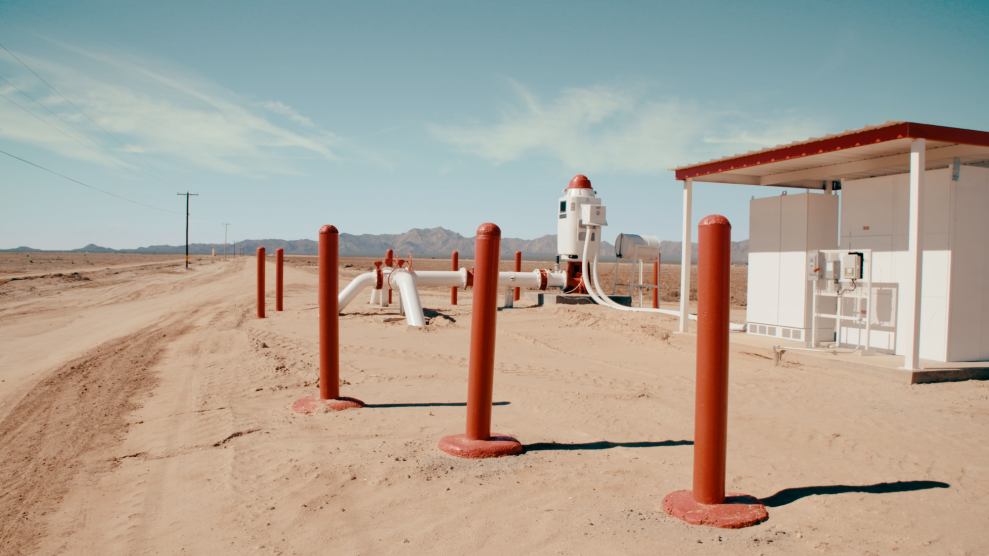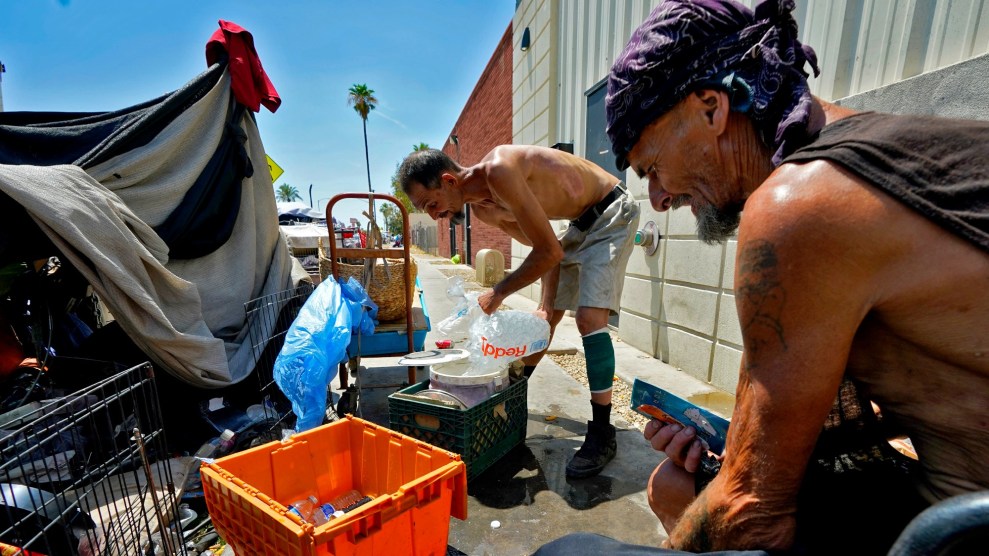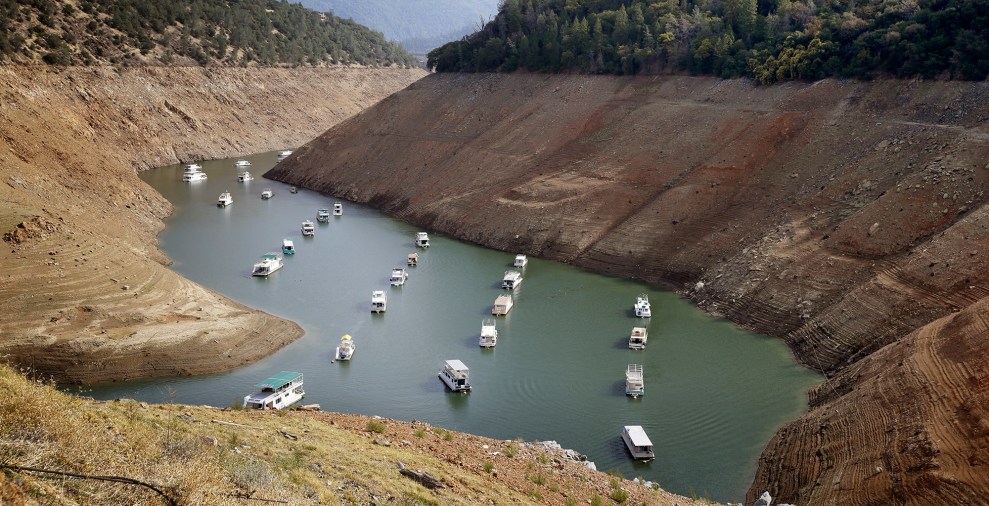
A new groundwater pump was installed for farming in La Paz County, Arizona, in 2017. Débora Souza Silva
This article is a collaboration between Mother Jones and Reveal from The Center for Investigative Reporting, a nonprofit investigative newsroom. Also listen to Reveal’s accompanying podcast, “The Great Arizona Water Grab.”
As rural Arizonans face the prospect of wells running dry, foreign firms are sucking up vast amounts of the state’s groundwater to grow hay for Saudi Arabia and other wealthy nations. Now it turns out that a key investor in this water transfer scheme is Arizona’s own employee retirement fund.
In La Paz County, a rural community about 100 miles west of Phoenix, Al Dahra Farms USA has been running a 3,000-acre farming operation in the Sonoran desert, draining down the same groundwater that the county’s residents rely on to fill their wells. The Emirati-owned farming company tapped into a former public water supply in 2013 to grow hay that gets shipped to countries in Asia and the Middle East.
The state of Arizona helped fund the land deal that allowed Al Dahra to tap into the groundwater in La Paz County, according to records obtained by Reveal. The state’s retirement system invested $175 million in 2012 into an East Coast company that bought about 20 square miles of land that had previously been set aside as a public water source. The company, International Farming Corporation, then leased some of the land to Al Dahra.
Al Dahra is now a key player in the booming business of tapping into Arizona’s limited water to grow hay that gets shipped overseas, which economists say is the equivalent of exporting the state’s scarce water. A Saudi-owned farm, which is also in La Paz County, has made international news for growing hay in the parched Sonoran desert even as Saudi Arabia has severely restricted its own hay production due to its water scarcity. But in Arizona, hay exports have increased nearly 100-fold in the last 10 years. The water used to grow the exported hay last year was equivalent to the water used by about one million people in the state, according to a recent paper from researchers at the University of Arizona.
The state’s investment into exporting its own water comes as the region faces ongoing water shortages. Arizona Governor Katie Hobbs announced this year that parts of the metro Phoenix area don’t have enough water to continue building new houses amidst ongoing groundwater depletion. The state also faces the likelihood of further reductions in water supplied from the dwindling Colorado River.
Since the state-funded investment company bought the land in La Paz County, it has drilled new, deeper wells. People living nearby say they are now losing access to their only source of water, their groundwater, as the water table drops as a result of the intensive farming. As their wells go dry, they are faced with tough choices. Some homeowners spend tens of thousands of dollars to drill their wells deeper, or have water trucked in. Others just leave.
“The stakes are our future,” said Holly Irwin, one of three elected supervisors in La Paz County who has been pushing back against the expanding hay farm. “We have a right to be here too, and not just those with the big bucks.”
Irwin said the state-funded project is threatening to destroy the rural way of life in this part of the Sonoran desert. She was outraged when presented with documents from the Reveal investigation showing her own retirement money was invested in the very scheme she was fighting to stop.
“It makes me angry, you know. It’s unbelievable that the state can do that with our retirement fund,” Irwin said. “I’ve been fighting for years to keep the water here, and it’s just frustrating everywhere you look around, you know, that this water is being depleted and alfalfa hay is being shipped overseas.”

County Supervisor Holly Irwin talks about water issues with diners at Don’s Historic Cactus Bar & Restaurant in Salome, Arizona, in 2020.
Jonathan Ingalls
La Paz County is a largely low-income part of the state, but it has a very valuable asset: an aquifer with water that has been targeted by wealthy cities, billion-dollar investment and farm companies, and the state’s own $49 billion retirement fund.
Many communities in the county rely entirely on the aquifer to supply their homes with water for drinking, showering and all their other needs. Arizona law allows homeowners, businesses and farms to drill wells on their own properties and pump up as much water as they want. The unregulated aquifer has attracted investors and farmers from far and wide.
In 1986, the roughly 20 square miles of land in La Paz County was purchased by the city of Phoenix to serve as a backup for its own municipal water supply. The city estimated it could use the land to tap into the groundwater, pump it to a canal, and deliver water for up to about 150,000 homes. But Phoenix never tapped the resource, and instead leased the land to a local Arizona farmer who grew less water-intensive crops..
The city assessed the aquifer in 2011 and found that the desert monsoon rains recharged the aquifer enough each year to allow the current homeowners in La Paz County to live there indefinitely, but that as a result of agricultural use, the water table was dropping up to 5 feet per year. Eventually, it would run out and homeowners would lose access to the vital water source.
In 2012, the city decided to sell the land atop this public water supply for $30 million to the North Carolina-based International Farming Corporation, which manages about $2.2 billion in agricultural investments. That same year, the Arizona State Retirement System invested $175 million with the firm.
Managers at the state retirement system knew that part of their investment was going directly into the land deal in La Paz County. The retirement system—as a major investor in the deal—was given the first right to make an offer on the farmland and the underlying water rights if International Farming Corporation decided to sell.
Paul Matson, executive director of the Arizona State Retirement System, declined a request for an interview about the investment, including whether the agency considers the impact of its investments on communities. In response, a spokesperson wrote that its mandate is “maximizing returns within prudent risk.” The statement went on to say that the investment in the land deal was an alternative to the stock market and a means to create good returns even during periods of high inflation.
These types of farmland investments are usually held for about 10 years and then cashed out, the retirement system said in its statement. It is now in the process of cashing out its investment, and expects by next year it will no longer be invested with International Farming Corporation.
The state’s retirement system has about 600,000 members, including teachers and other state and county employees, and is one of the biggest investors in the La Paz County land deal orchestrated by International Farming Corporation. The state provided nearly half of the $430 million that the IFC-controlled fund aimed to raise for investments in farmland and associated water rights, according to state and federal records.

Bales of hay are stacked high at a megafarm in the Arizona desert.
Still from “The Grab”
The state’s $175 million investment was commingled with money from other investors into a limited partnership fund controlled by IFC called U.S. Farming Realty Trust II. The fund then purchased farmland across the country, including the land in La Paz. Retirement money for the IFC-controlled fund also came from New York City teachers, union workers in California and Michigan, and even money from Carnegie Hall, the storied concert venue in New York City. All were invested directly or indirectly in the Arizona land deal, part of a growing trend by retirement funds and other institutional investors to fund large-scale farm deals that control water supplies at a time when scarcity of both food and water is expected to worsen.
In particular, investors are increasingly targeting water rights in arid regions of the United States. In a 2022 prospectus shared with potential investors, IFC wrote that the water rights associated with land deals are a key component of the value of any potential investment and that “water rights in Southern California and Arizona are expected to increase in value.”
International Farming Corporation executives also declined to be interviewed by Reveal. In a statement, they wrote that IFC complies with state water laws, uses advanced irrigation systems and is committed to the long-term success of the local agricultural communities that it’s part of.
The company listed the 14,000-acre property in La Paz County for sale in 2020 for $100 million dollars, more than three times what it paid for it less than a decade earlier. The state-funded investment property remains for sale today, according to IFC, although it declined to provide the current list price.
After Reveal broke the story in 2015 about the nearly 10,000 acre Saudi-owned farm growing and exporting hay in La Paz County, it became a central campaign issue in Arizona for both Republican and Democratic candidates, who criticized the farm and its use of the state’s scarce water. Now, through the Al Dahra farm, politicians find themselves invested in the same use of water they have campaigned against.
Attorney General Kris Mayes called the Saudi land deal “one of the greatest scandals in the history of Arizona,” in a recent interview with Reveal. She now expects Arizonans will be just as outraged that she and other public employees’ retirement funds are invested in a deal that further drains the state’s precious water.
“It just exacerbates an already terrible situation and shows again the abject failure of our government to protect our people and to protect our future,” Mayes said. “Our very survival as a state depends on our doing better when it comes to water.”
Mayes, who was elected in 2022 and took office this year, said she planned to look into the investments made by the state’s retirement fund.
Ironically, in making the investment in the land deal, the state of Arizona is capitalizing on its own lax water laws in rural communities, which allows landowners to pump unlimited amounts of groundwater.
Kathy Ferris is the former head of the state’s water department and helped craft the state’s 1980 Groundwater Management Act that protected aquifers in urban areas such as Phoenix, but not in rural areas such as La Paz County – a compromise between those who saw the need to regulate water across the entire state, and those who didn’t want any regulation. Now with the increased investment into pumping out Arizona’s rural water, Ferris said lawmakers need to update the state law to protect the rural aquifers.
“I’m disappointed. I’m disappointed in the lack of action,” Ferris said. “People will continue to come here and sink deep wells in these unregulated areas and do what they want with that groundwater because they can. Or until the groundwater runs out. And then they will leave.”
Michael Montgomery contributed reporting.

















